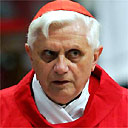New Pope had brief stint in the Hitler Youth Movement
Ratzinger was just elected Pope, this was written a few days before his victory.
Justin Sparks, Munich, John Follain and Christopher Morgan, Rome | Tuesday 19th April 2005
 THE wartime past
of a leading German contender to succeed John Paul II may return to haunt
him as cardinals begin voting in the Sistine Chapel tomorrow to choose a new
leader for 1 billion Catholics.
THE wartime past
of a leading German contender to succeed John Paul II may return to haunt
him as cardinals begin voting in the Sistine Chapel tomorrow to choose a new
leader for 1 billion Catholics.
Cardinal Joseph Ratzinger, whose strong defense of Catholic orthodoxy has earned him a variety of sobriquets - including “the enforcer”, “the panzer cardinal” and “God’s rottweiler” - is expected to poll around 40 votes in the first ballot as conservatives rally behind him.
Although far short of the requisite two-thirds majority of the 115 votes, this would almost certainly give Ratzinger, 78 yesterday, an early lead in the voting. Liberals have yet to settle on a rival candidate who could come close to his tally.
Unknown to many members of the church, however, Ratzinger’s past includes brief membership of the Hitler Youth movement and wartime service with a German army anti- aircraft unit.
Although there is no suggestion that he was involved in any atrocities, his service may be contrasted by opponents with the attitude of John Paul II, who took part in anti-Nazi theatre performances in his native Poland and in 1986 became the first pope to visit Rome’s synagogue.
“John Paul was hugely appreciated for what he did for and with the Jewish people,” said Lord Janner, head of the Holocaust Education Trust, who is due to attend ceremonies today to mark the 60th anniversary of the liberation of the Bergen-Belsen concentration camp.
“If they were to appoint someone who was on the other side in the war, he would start at a disadvantage, although it wouldn’t mean in the long run he wouldn’t be equally understanding of the concerns of the Jewish world.”
The son of a rural Bavarian police officer, Ratzinger was six when Hitler came to power in 1933. His father, also called Joseph, was an anti-Nazi whose attempts to rein in Hitler’s Brown Shirts forced the family to move home several times.
In 1937 Ratzinger’s father retired and the family moved to Traunstein, a staunchly Catholic town in Bavaria close to the Führer’s mountain retreat in Berchtesgaden. He joined the Hitler Youth aged 14, shortly after membership was made compulsory in 1941.
He quickly won a dispensation on account of his training at a seminary. “Ratzinger was only briefly a member of the Hitler Youth and not an enthusiastic one,” concluded John Allen, his biographer.
Two years later Ratzinger was enrolled in an anti-aircraft unit that protected a BMW factory making aircraft engines. The workforce included slaves from Dachau concentration camp.
Ratzinger has insisted he never took part in combat or fired a shot - adding that his gun was not even loaded - because of a badly infected finger. He was sent to Hungary, where he set up tank traps and saw Jews being herded to death camps. He deserted in April 1944 and spent a few weeks in a prisoner of war camp.
He has since said that although he was opposed to the Nazi regime, any open resistance would have been futile - comments echoed this weekend by his elder brother Georg, a retired priest ordained along with the cardinal in 1951.
“Resistance was truly impossible,” Georg Ratzinger said. “Before we were conscripted, one of our teachers said we should fight and become heroic Nazis and another told us not to worry as only one soldier in a thousand was killed. But neither of us ever used a rifle against the enemy.”
Some locals in Traunstein, like Elizabeth Lohner, 84, whose brother-in-law was sent to Dachau as a conscientious objector, dismiss such suggestions. “It was possible to resist, and those people set an example for others,” she said. “The Ratzingers were young and had made a different choice.”
In 1937 another family a few hundred yards away in Traunstein hid Hans Braxenthaler, a local resistance fighter. SS troops repeatedly searched homes in the area looking for the fugitive and his fellow conspirators.
“When he was betrayed and the Nazis came for him, Braxenthaler shot himself because he knew he couldn’t escape,” said Frieda Meyer, 82, Ratzinger’s neighbour and childhood friend. “Even though they had tortured him in Dachau concentration camp he refused to give up his resistance efforts.”
Despite question marks over Ratzinger’s wartime conduct, the main obstacle to his prospects in the conclave - the assembly of cardinals to elect the new pope - is the conservative stance he has adopted as guardian of Catholic orthodoxy since John Paul named him to head the congregation for the doctrine of the faith in 1981.
His condemnations are legion - of women priests, married priests, dissident theologians and homosexuals, whom he has declared to be suffering from an “objective disorder”.
He upset many Jews with a statement in 1987 that Jewish history and scripture reach fulfillment only in Christ - a position denounced by critics as “theological anti-Semitism”. He made more enemies among other religions in 2000, when he signed a document, Dominus Jesus, in which he argued: “Only in the Catholic church is there eternal salvation”.
Some of his staunchest critics are in Germany. A recent poll in Der Spiegel, the news magazine, showed opponents of a Ratzinger papacy outnumbered supporters by 36% to 29%.
As one western cardinal who was in two minds about him put it: “He would probably be a great pope, but I have no idea how I would explain his election back home.”
One liberal theologian, when asked what he thought of a Ratzinger papacy, was more direct: “It fills me with horror.”
